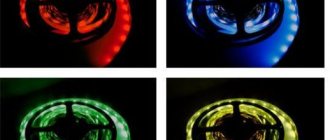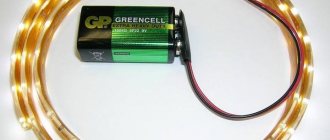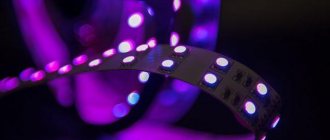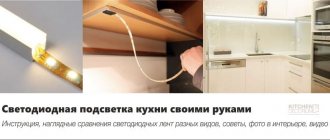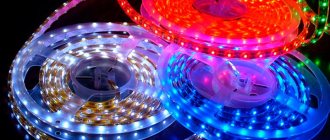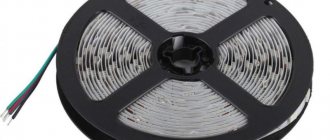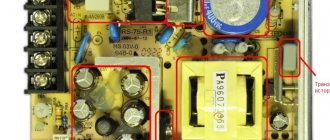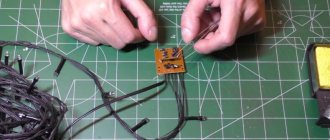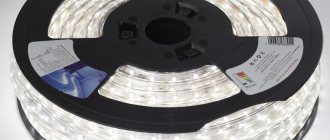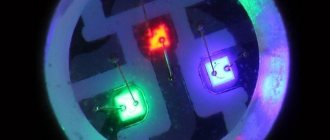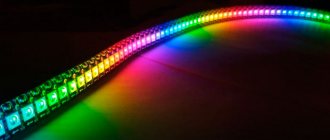They need a device that converts 220V alternating voltage into 12V or 24V direct voltage. This is a kind of step-down electronic transformer.
Of course, there are tapes that operate on other voltages, but the most popular are 12-volt models.
How to choose a ribbon
First you need to choose the right tape. An important factor when choosing is the purpose for which the backlight is installed. The tapes vary depending on the number of light bulbs located on one meter of tape. There are 30, 60, 120 and 240. The more bulbs, the brighter the light.
Next, you need to decide on the place where the tape will be located. Like any electrical device, it is afraid of moisture. But there are several types of tapes adapted to aggressive environmental influences. This can be found out by reading the label. IP20 is practically not protected. It should not be placed above the sink in the kitchen, bathroom or outdoors. Rather, she will have to illuminate bookshelves or paintings in the interior. IP65 is protected enough for use in the kitchen or bathroom. It also works great with outdoor lighting. IP68 is an absolutely protected tape that is easily suitable even for lighting swimming pools.
For further operation of the tape, you need to understand what kind of backlight is needed - monochrome or multi-colored, warm or cold. And, of course, pay attention to the size of the illuminated surface. All this should be taken into account when deciding on the purpose of the tape.
Conditions for using battery-powered LED lighting
However, this connection of the LED strip has its limitations. And it cannot be used everywhere and not always.
The main disadvantage is its short length and low power.
With a large length of LED strip, for example, lighting around the entire perimeter of a house or a large room, you will still have to use a regular power supply with a traditional mains voltage of 220V.
So where can battery-powered LED strips be used?
- cabinets
These can be either cabinets in the bedroom (with clothes and shoes) or in the kitchen (with dishes and various kitchen utensils).
- bookshelves or paintings
Such lighting will no longer spoil the appearance of the canvas with ugly wires, but will only emphasize its beauty.
- small garage spaces
- cellar in a garage or shed
Here the main advantage of battery-powered lighting is fully reflected - autonomy and independence from alternating mains voltage.
- temporary lighting of premises in emergency situations and complete absence of power supply in a house or apartment
- illumination of the work surface in the kitchen, illumination of the bathroom or balcony
Just do not forget in this case to use a waterproof and sealed LED strip with protection IP 55.65.
- stage performance clothing
- sports equipment, bicycles
- car showrooms
You can add additional application options yourself, depending on your fantasies and needs.
Quantity
There are a few other differences to keep in mind when choosing tape. When connecting to power sources, you will have to be guided by these data. Light bulbs located on the segment make the ribbon unique. For example, if there is only one LED on one segment, then the strip will be marked as follows: 5 V. If there are 3 LEDs on a segment, then it is a 12 V strip. There is also a 24 V strip, which has 6 LEDs on a segment. Such tapes are very convenient, as they can be cut into pieces of almost any length. For 220 V strips, the segment can be 1 meter, and 60 LEDs will be located on it. If there are 120 diodes on a meter, then the cutting pitch can be 50 cm. Their disadvantage is that you will have to purchase tape, measuring the pieces by meter, at least half a meter. The most common tapes on the market are 12 V and 220 V. As a rule, adapters are sold immediately with a roll of tape. But if you need a small piece, you will have to purchase everything separately.
LED strip 220V
LED RGB strip
In addition to 12V strips, there are strips designed for 24, 48, 110 and 220V. The number of diodes in indivisible segments is, respectively, 6, 12, 30 and 60 pieces. Without a transformer or other power supply, only through a rectifier, only 220V strips are plugged into the outlet.
Such devices are assembled from SMD 3528, 5050, 2835, 3014 and extra-bright 5630 LEDs. Such strips are cut only in sections of 50 centimeters or 60 diodes connected in series. Externally, these devices differ from ordinary ones only in markings.
Main parameters of 220V LED strips
The main parameters of these devices are:
- length of the minimum segment;
- number of diodes, power and current of one meter of strip;
- protection from weather conditions;
- color temperature of white light.
To solder or not to solder?
When starting to work with an LED strip, you need to know that to connect it to the network, there are two connection methods - soldering and connector. Experts say that soldering the tape is much cheaper and more reliable than using plastic connectors to connect it. The connectors themselves are plastic clips with two contacts for single-color ribbons and four for multi-colored ones. Working with them is quite simple. It is better to use such a connection where it is not possible to solder the tape, or if it needs to be bent at an angle. Then corner connectors or with a bend will come in handy. Still, it’s better to arm yourself with a soldering iron and do it in a more reliable way.
To work, you will need the tape itself, a low-power soldering iron with a thin tip and adjustable temperature, solder, rosin and double-sided tape to which you can glue the tape while working, and heat-shrink tube. You also need the devices necessary to connect the tape to the power supply, namely a power supply, wires connecting the tape to the block and the block to the network, and, if necessary, a switch or socket.
Working with a soldering iron itself requires a certain skill, but you can do it if you want. You should start by preparing the place to work. It must be a hard and level surface, protected from possible fire. Next, you should pay attention to the soldering iron. It should be cleaned as necessary, perhaps using sandpaper or a wire brush. Carefully remove any remaining dirt using a sponge or cloth. The tape must be secured to the work surface so that it does not move during operation. Double-sided tape is useful for this if there are no other devices for attaching parts. The tape must be cut at the indicated place where the scissors are shown. The wires need to be stripped and freed from insulation, then cleaned a little again with a knife. Determine where the plus and minus are located and strictly follow the connection rule. Next, you need to clean the contacts on the tape and apply a thin layer of solder. The tape has paired contacts for connection, so the wires need to be soldered in two places, bending them at an angle of 90˚ in different directions. Next, the soldering points need to be protected with a special heat-shrinkable tube. If rosin was used during soldering, then you should not strip it, as it can also act as insulation.
Electrical connection
If you will be using a home network, then it is worth studying in detail how to power the LED strip from 220 Volts. As mentioned above, during installation you will need a power supply. For such a tape, a power supply is not needed, but a special wire will be useful, which will serve as a diode bridge. When you have figured out how to power an LED strip from 220 Volts, you need to take into account that other types of strips over 5 meters will have to be powered not linearly, but in parallel. The good thing about a 220 V LED strip is that it can be purchased immediately in a 100 m coil or connected linearly to the desired length. Such long strips are needed for decorative lighting of houses or swimming pools. If you need a shorter piece, you can simply cut it at the cut site and install a protective plug. However, the absence of a power supply when installing this tape can lead to some problems. Voltage fluctuations will negatively affect the diodes. This can lead to rapid burnout and obsolescence of entire sectors. In addition, it must be taken into account that due to the lack of the same power supply, such tapes exhibit flickering, which the human eye is sometimes unable to detect, but it will negatively affect well-being. Therefore, 220 volt strips are best placed on the facade of a house or as illumination on the street during the New Year holidays. These tapes are insulated with silicone, which makes them indispensable in Russian weather conditions.
Batteries to the rescue
If you need to illuminate a small area, then read how to power an LED strip from batteries. The principle of this method is not too different from all previous ones. When connecting all elements, you need to remember the polarity and choose materials suitable for connection with the selected tape. The batteries must have a total voltage of 12 volts. It can be any battery, even a little one or a tablet. It will be good if it is battery-powered. Then the problem of replacing batteries will be replaced by timely recharging of the battery. Below is how to power the LED strip from batteries:
- First you need to clean the contacts well.
- Tin the ends of the copper wires.
- Apply flux and solder the wires to the battery - red to positive, black to negative.
- Do the same with a button or toggle switch. Just pass only one wire through it (positive) and solder it to the input of the toggle switch. The output is released onto the tape.
Battery connection
Now it’s clear how to power the LED strip. But what if you need light not at home, but, for example, outdoors in a tent? If the picnic lasts several days, no battery will be able to withstand such a long period. Therefore, you need to think about how to power the LED strip from a battery. There are special batteries with capacities from 2 to 100 Ah that can be used for such purposes. The only difficulty may lie in the fact that there are special connections to the battery, which again will have to be connected to the tape. By the way, if you decide the question of how to power a 12V LED strip, then this is exactly the case.
LED strip design
The LED strip is a printed circuit board on a flexible base of insulating material. Along this strip there are two conductive strips with contact pads. Between the strips there are groups of LEDs and current-limiting resistance. All elements are connected in series and are housed in an SMD housing.
In the most common strips, the number of LEDs in a group is three, and the supply voltage = 12V. These groups are separated by contact pads with a cut line mark. The strip can only be cut in these places. If you cut in another place, the cut group will not work.
The size of LEDs and their number per meter of strip may vary. The brightness of the light and power consumption depend on this.
LED strip device
Important! The LED supply voltage must be constant and without ripple, otherwise the light will flicker, which is unpleasant and harmful to the eyes.
Computer connection
If you are still concerned about the question of how to power a 12-volt LED strip, then you can think about computer spare parts. This option is suitable for those who understand not only the connection of electrical elements, but also electronics. It is knowledge of computer hardware that can be useful in this situation. When considering the question of how to power an LED strip, one cannot help but remember that in our age there are much more possibilities than our parents had. It is impossible to imagine a single home without a computer. This raises a new question: is it possible to power an LED strip from a computer power supply? With a little knowledge, anything is possible. A block from any old computer that had to be disassembled for reasons not related to a malfunction of the block will come in handy. All wires must be present. For this purpose, we need a yellow wire, which is powered by 12 W, and a black wire, which will serve as a grounding wire. The remaining wires will not be useful. You can learn more about the process thanks to the instructions presented in the video.
So, how to power an LED strip with 5 Volts? You don’t often see such tapes in stores, but if you set your mind to it, you can actually buy them on the Internet. They are generally suitable for use with a USB cable. And if for some reason the question arises of how to power the LED strip from USB, you need to do the following: solder a wire to the strip, then directly connect the USB connector to it, having first cut it off, leaving a wire at least 5 cm long at the end. Clean the wires on both sides and connect them, observing polarity. You can skip soldering and use regular electrical tape. This method is not designed to last long, but can be useful as a temporary solution to the problem. Suitable as mobile lighting powered by a phone battery.
Advantages of this connection method
Strips with LED lamps are designed for voltage of 12 or 24 V, which requires the installation of a transformer. During operation, the converter heats up and requires ventilation to remove excess heat.
The use of a portable, replaceable power source makes it possible to simplify the electrical circuit and increase the reliability and safety of the backlight.
The main advantages of a battery-powered LED strip:
- no transformer and rectifier are required, which must correspond to the power of consumers;
- ease of connecting a DC source to the tape;
- no need to hide additional wires laid from the 220 V outlet to the transformer;
- there is no need to install an outlet near the LED strip installation area;
- the absence of a transformer increases the reliability of the lighting system;
- It is possible to install the tape on portable interior elements or children's toys.
Additional features
How else can you use LED strips? For example, if you correctly install tapes in cabinets, you can not only decorate your home, but also make it more functional. On a shelf with clothes, on the steps of a staircase, above the sink in the kitchen or as a backlight in a cupboard - a smart tape is suitable for all this. And although it has some disadvantages, at the moment it is the most economical of the additional power sources. Long service life of diodes, low electricity consumption, alternative power sources, mobility and appearance that does not spoil the interior of the room - all this speaks in favor of LED strips.
Simply and easily
So, having figured out how to power the LED strip, we conclude that if you have the desire and additional sources of information, this can be done with your own hands. And if you remember that installing such lighting by a master will be about one and a half to two times more expensive than the materials themselves, then you should definitely try your hand at this, possibly new business. It is, of course, necessary to observe safety precautions when working with electrical devices.
Set contents
When purchasing an LED strip, you may want to pay attention to ready-to-use lamps. This is an easier way to illuminate areas in your home. With some diligence, you can now find lighting fixtures to suit every taste and budget. In addition, sometimes assembly from separately purchased elements can be much more expensive than ready-made products. The tape itself cannot provide lighting without additional devices. For it you should also purchase a power supply, an adapter, an adapter and a certain amount of wire with which it all is connected. For a professional this will not be difficult. But an amateur will have to write down all the required characteristics, draw a connection plan, put all the parts together, try not to mix up the wires and thus not destroy all the purchased materials. And the result may be far from the plan.
At the same time, the master, when assembling the lighting, is able to control the quality of the material used, the work on the installation of the structure and placement. If you want to become a real master and decorate and ennoble your home as much as possible, you need to start small and simple, gradually moving on to more complex elements.
In conclusion, it should be recalled that when assembling more economical lighting, you should not purchase cheap materials. As they say, the miser pays twice, or even more. There are many offers from Chinese craftsmen on the Internet. It’s just that the lack of any guarantees, and sometimes even markings, makes you wonder whether their use will lead to a sharp reduction in service life or to more irreparable problems in the form of an accidental fire or harm to health. It is worth paying attention to the choice of not only the material itself, but also the manufacturer.
What brands to pay attention to
Nowadays power supplies for LED flexible circuit boards are not produced, perhaps only by lazy people. Therefore, choosing a power supply for an LED strip based on the manufacturer is an extremely thankless job. Nevertheless, focusing on the rest of the products of these companies, we can fairly accurately say how high quality their blocks will be.
Today, Russian Arlight and Taiwanese Mean Well Enterprises Co. have proven themselves well. It makes sense to pay attention to the products of these brands first. In addition, I would like to mention the Chinese Biom, whose products are notable for their low price and good quality. Below we present a selection of six 12-volt power supplies from these companies, the most popular among tape users.
Popularity rating of power supplies for LED strips
| Rating | Photo | Model | Manufacturer | Input voltage, V | Output voltage, V | Output power, W | Output current, A | Degree of environmental protection | price, rub. | Where can I buy |
| 1 | Mean Well LPV-100-12 | Mean Well Enterprises Co. (Taiwan) | 90~264 V AC/127~370 V DC | 12 | 100 | 8.5 | IP67 (sealed) | 1 200 | Ya.Market | |
| 2 | ARPV-LV12060 | Arlight (Russia) | 100~240 V AC | 12 | 60 | 5 | IP67 (sealed) | 2 700 | Ya.Market | |
| 3 | Mean Well LRS-150-12 | Mean Well Enterprises Co. (Taiwan) | 85~264 V AC | 12 | 150 | 12,5 | IP20 | 1 100 | Ya.Market | |
| 4 | Biom Professional BPU-25 2A | Biom (China) | 176~264 V AC | 12 | 25 | 2 | IP20 | 320 | – | |
| 5 | ARS-35-12 | Arlight (Russia) | 100~240 V AC | 12 | 35 | 3 | IP20 | 1 500 | Ya.Market | |
| 6 | JTS-100-12-FA | Arlight (Russia) | 100~240 V AC | 12 | 102 | 8,5 | IP20 | 2 600 | Ya.Market | |
| 7 | Biom TR-60-12 | Biom (China) | 176~264 V AC | 12 | 60 | 5 | IP20 | 250 | – |
